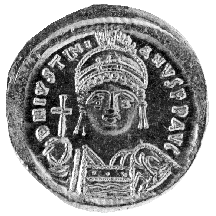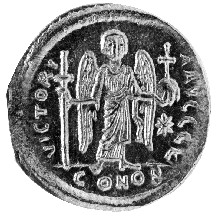



(132) Justinian I - AV solidus, A.D. 527-545, 4.45 g. (inv. 91.270).
Obverse: Facing helmeted and cuirassed bust of Justinian,
holding globus cruciger in r.; at l. shoulder, shield with attacking
horseman; D(OMINVS) N(OSTER) IVSTINIANVS P(ER)P(ETVVS) AVC(VSTVS): Our lord
Justinian, perpetual Augustus.
Reverse: Standing facing angel with cross-staff in r. and
globus cruciger in l.; VICTORIA AVCCC (AVGVSTORVM abbreviated) E:
Victory of the Augusti, officina mark E; in exergue, CONOB: gold
of Constantinople.
Provenance: Hesperia Art, 1959.
Bibliography: P. Grierson, Byzantine Coins (London
1982).
Justinian's accomplishments in military affairs, the law, and the arts were
among the greatest of the Byzantine empire. He reclaimed most of the territory
of the Roman empire, codified the old Roman law, and built Hagia Sophia
and other important churches and monuments in Constantinople. Underlying
his temporal victories was a strong personal conviction for orthodox Christianity.
Justinian's policy of reconquest is made clear on the obverse of this coin.
In place of the usual spear, in his right hand the emperor holds the globus
cruciger, a globe surmounted by a cross, indicating that the emperor
receives his authority from God. From this time onward the globus cruciger
would become a regular feature of the Byzantine imperial bust. On earlier
coins the globus had been held by Victoria on the reverse (see no.
131).
Although stylized in the manner of most Byzantine coin portraits, this portrait
type may bear some resemblance to the emperor, for Justinian's biographer,
Procopius, writes that he was "rather plump," his face "round
and not unattractive" (Secret History, 8).
T.S.R.



All contents copyright (c) 1996.
Lawrence University
All rights reserved.